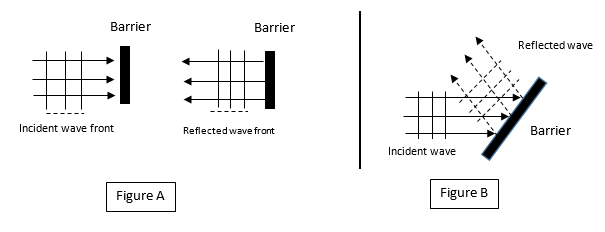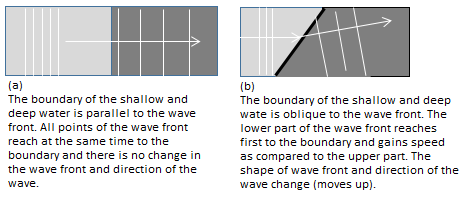Comprehensive Question 7: Using ripple tank, explain reflection, refraction and diffraction of waves.
Answer
Reflection
When a wave travels in one medium falls on the boundary of another medium and returns back into the same medium, the phenomenon is called reflection.
When waves are produced in a ripple tank and their motion is obstructed by placing a straight barrier, they are reflected back. When the barrier is kept straight in the path of the wave (Fig A), the wave is reflected back along its original path. Similarly, when the barrier is kept obliquely (Fig B), the wave is reflected back at an angle to the barrier.

Reflection
When waves enter from one medium to another, their speed changes. This phenomenon is called refraction of wave. Since the frequency of the wave is constant, therefore by universal wave equation, v = fλ, the wavelength of the wave also changes. If the speed of wave decreases, the wavelength also decreases and vice versa.
Since speed of water wave changes when the depth of water changes, therefore this effect can be demonstrated in the ripple tank without changing from water to another medium.
Consider water waves in a ripple tank. Place a thick sheet of plastic in the path of the wave. This makes this part of the tank shallower than the part where there is no plastic sheet. When water goes from the shallower part to the deeper one, its speed increases and we see a corresponding increase in the wavelength of the wave.
If the wave crosses the boundary of the deep and shallow parts straight, there is no change in the direction of the wave. However, when the wave front meets the boundary at an angle, the direction of the wave also changes. This can be explained on the basis of universal wave equation.
Consider a wave front reaching the deeper part at some angle. More clear from the below figure, part of the wave front reaches earlier to the deeper area than the other parts. By universal wave equation, v = fλ, its wavelength and speed increases as compared to the parts which reach later to the deeper area. As a consequence, the shape of the wave front, and therefore, direction of the wave changes as well.

